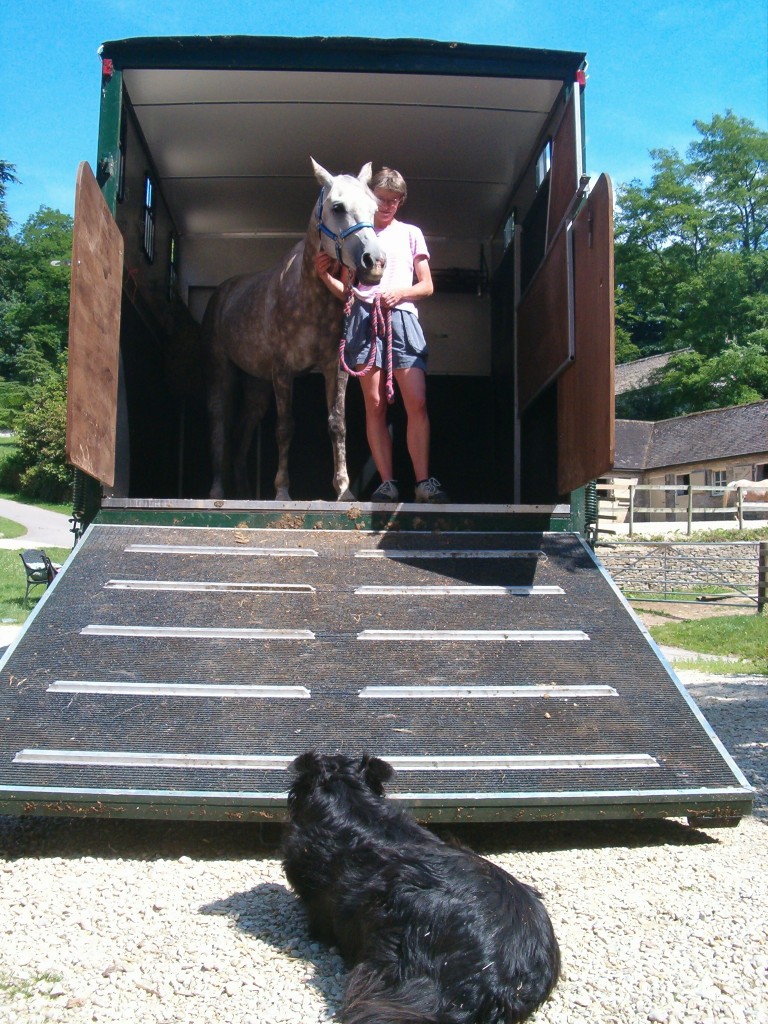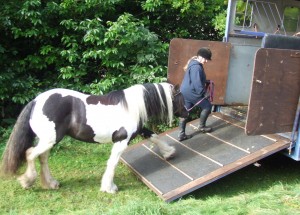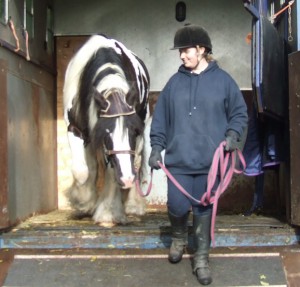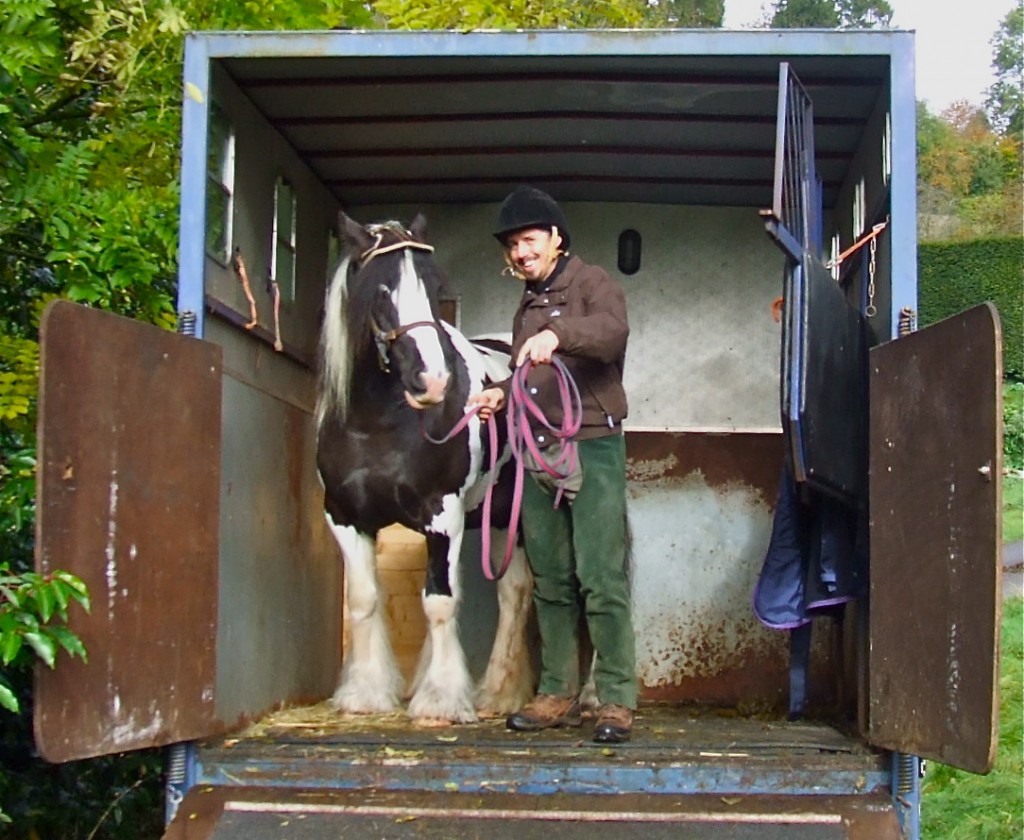More About Loading
Our aim isn’t just to get the horse loading happily on the lorry or trailer, it’s also to equip you with the skills to deal with situations that might arise. After all, your horse may load perfectly from home, but struggle coming back from a show, or there may be a long gap between outings, and you may find they are a bit sticky and need a bit of reminding. Instead of needing another callout, you’ll be empowered yourself to get this kind of thing completed by yourself, in all but the most extreme and exceptional cases (we are always ready to help you more than once, of course).
It’s very important to be realistic about your horse’s individual needs. Your commitment to homework may be necessary, if you want to fix every aspect of a complex case of loading, claustrophobia, fear of travelling, noise, vibration etc, without it costing more than you can afford. In other words, getting the horse in is one thing, but getting the partitions across, the ramp up, and the horse happy in motion may be other issues entirely. We are very happy to assist in all of these areas, but we may need more than one session and it will obviously take longer.
People often ask how long the process is likely to take, and it can be very difficult to estimate: some horses that sound like they’ll be very difficult take very little time, others who seem like they should be straightforward might even, rarely, need a second visit. But 3-4 hours is usually sufficient to have a horse loading happily, with you confident in the process as well. Most people spend very little time practicing afterwards, and their horses load reliably thereafter.
A few considerations:
We need a safe surface to work on – this could be grass, although working in a school is best. We would make little mess- no more than a “proper” session of jumping, for example. Often the best place to be is in the doorway of the arena, a verge of grass next to a hedge or field entrance. In the interests of the horse’s safety, however, we can’t initially work on concrete or other hard surfaces, next to blackthorn bushes, barbed wire, ditches, or other such hazards. However, with enough work we are confident your horse will load without fear or hesitation in the location you usually would want to load him from.
There are a few provisos to that statement. Clearly a horse can revert if involved in an accident or incident. The trailer or lorry must be in good condition and an appropriate size for the horse, and stabilised adequately in the case of a trailer. We will need the partitions out to begin with. Some horses have a very severe aversion to partitions and this must be treated as a separate issue.
It’s important that the horse doesn’t have sharp teeth, as pressure from the headcollar or Dually would be uncomfortable. So please do arrange for them to be rasped if they haven’t been done within the last year. Sometimes loading issues can be caused by bad backs or sore hocks which make the ramp difficult for the horse.
Panels- like the metal ones Monty uses, but substitutes can generally be found – make the job of loading significantly easier, and mean that more time can be spent consolidating the work – obviously the horse has to be able to load without them eventually, but they can be almost essential sometimes to get the horse in initially. We have ideal panels but nothing to transport them in, so on rare occasions we might arrange for you to collect them from us. Many times there are good alternatives on the yard – gates covered with blankets so the horse can’t put a foot through, safe hedges, or partitions from the trailer or lorry might all work. Please ask your yard owner in advance whether they would mind if we make use of the best things we can find. A board made of plywood or similar, ideally about 8×4 ft, can be very helpful too. Sometimes we use tarpaulins as part of the training.
You will also need a hard hat, gloves, and suitable footwear. We will bring ropes, halters and poll guard. Travelling boots are optional, we’ll usually be happy with your preference, if you have a set. There are times when they can cause problems themselves- they mustn’t be too big or loose, and horses should be acclimatised to them before dealing with a loading phobia. If your horse is shod, however, you might want to use good brushing boots and perhaps overreach boots all around.
It’s usually Adam who does the visit, and he will often request to bring a student unless you would prefer him not to.
Charges are currently £44 per hour for working, and £30 per hour for travelling, with no additional charge for the student attending. You are very welcome to have spectators, for which we won’t charge, but you may do so and use the money to offset the cost of the visit. You could consider setting up a proper demonstration at your yard or a local indoor school that you can get to by riding there. Sell tickets at £10 a pop and you should be able to make a real dent in your costs at the very least, if you are willing to make the effort to advertise it and get the word round. If you decide to use your new-found loading skills to come on a clinic here, we will give you a 10% discount off that clinic!
As with any callout, once we have pencilled in a date, a deposit of £50 will secure the place. If there are adverse weather conditions, we’ll be happy to reschedule. Please also send detailed directions (if you use a website like the RAC or AA for this, please check that the last few lines will actually get us to you!), and include your mobile phone number if you have one, or your landline if the horse is at home or nearby. Adam usually leaves at 10am, and will ring you if he is running late at all.




